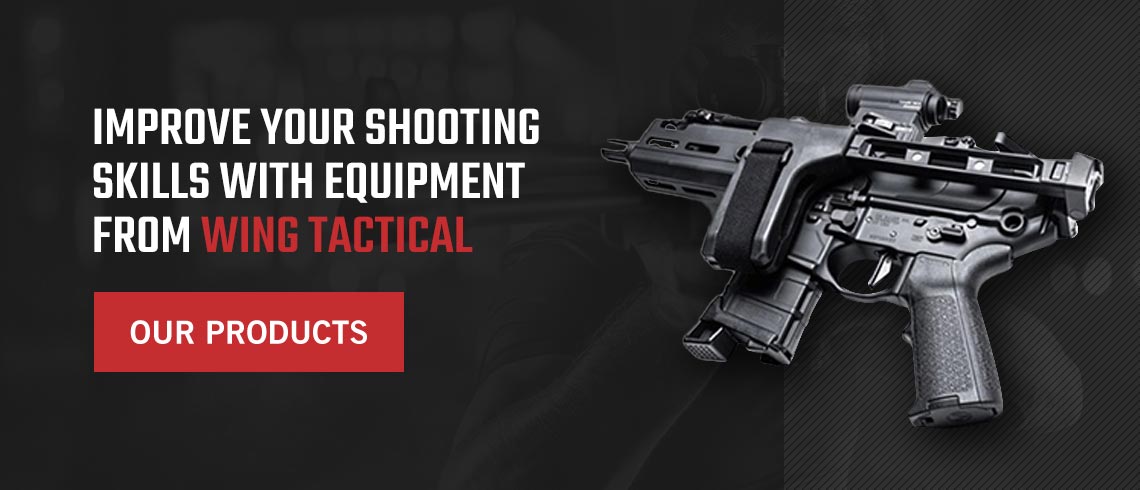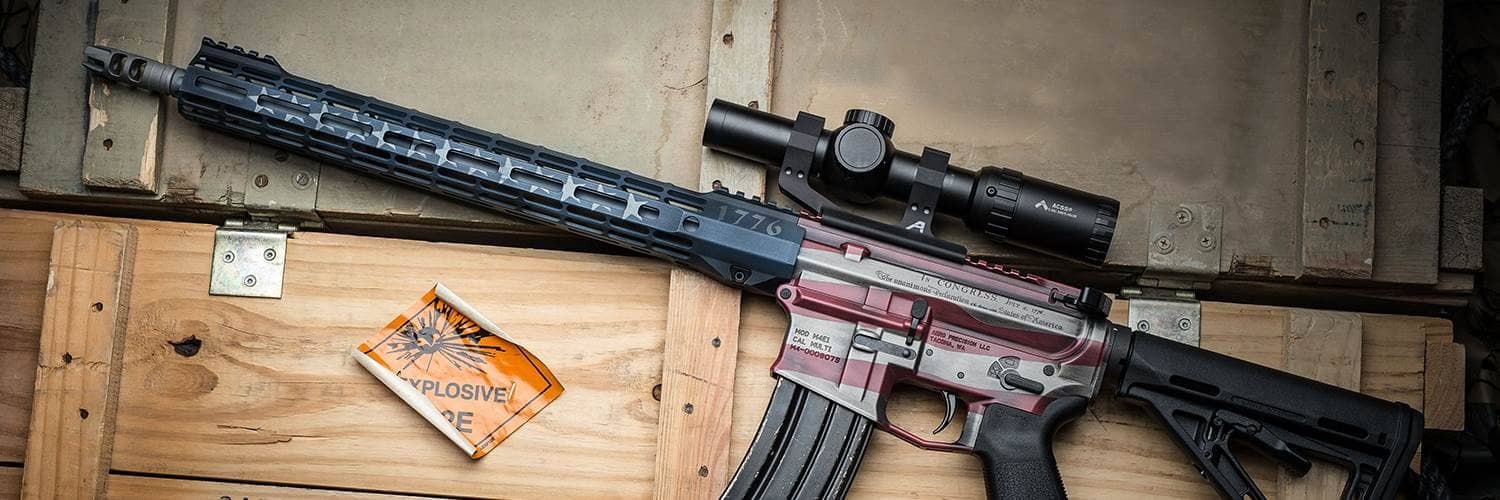
There are various reasons you might want to refine your shooting accuracy, such as if you are a military service member who prioritizes precision firing or a hunter who wants to ensure a clean and ethical shot every time. Sighting in a rifle scope is a valuable process that improves focus, accuracy and overall skill — however, mastering it requires lots of time, practice and patience.
Luckily, we've provided some handy tips in this comprehensive guide. Learn how to improve your shooting skills with these steps and recommendations for sighting in your rifle scope.
What Is a Rifle Scope?
A rifle scope is a shooting tool that helps you hit targets with long-range precision. A scope contains a set of magnification lenses and a reticle. The reticle determines where the ammo should impact the target. These tools collectively help you make more accurate shots from further distances.
The process of zeroing, or sighting in, involves adjusting the scope's windage and elevation. It allows the point of aim — or reticle position — to match the point where the bullet impacts your target.
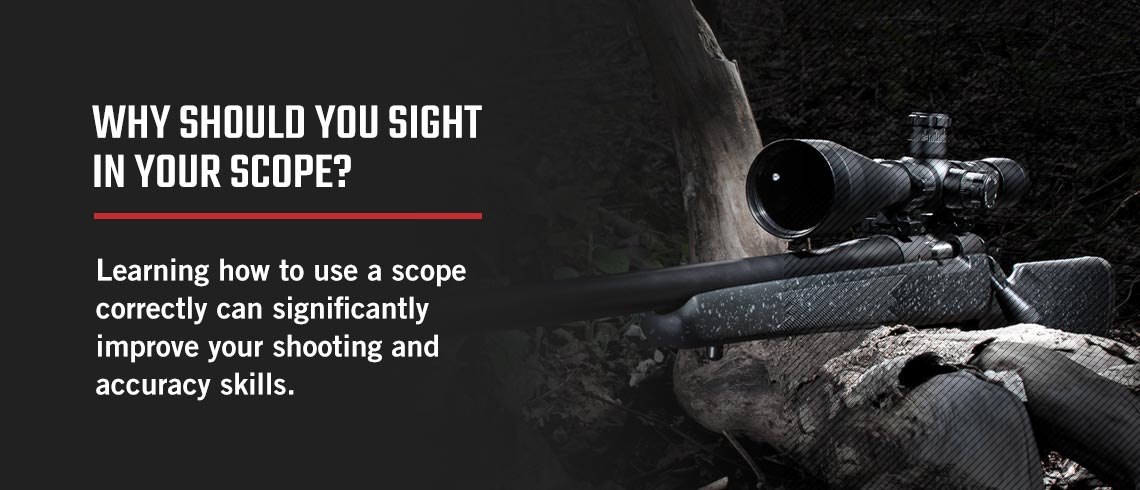
Why Should You Sight in Your Scope?
Sighting in your scope is essential to getting the best possible shot from your firearm. Learning how to use a scope correctly can significantly improve your shooting and accuracy skills. Consider these benefits of sighting in your scope.
- Longer-range shots: A scope uses powerful magnification that enables you to shoot targets from further away.
- Higher accuracy: Sighting in your scope helps you continue to shoot accurately from longer distances.
- Competitive edge: If you shoot competitively, using a scope gives you an advantage over shooters who don't by allowing you to fire more precisely and at longer distances.
- Improved confidence: When you use a scope to hit targets more accurately and consistently, you can feel more confident in taking on competitions and challenges.
- Increased safety: For instance, a scope can help ensure you're aiming at the right target when hunting at night. Some scopes feature night vision as an additional precaution.
Learning how to sight a rifle is a vital skill to master if you want to enhance your accuracy. Some technical knowledge is necessary for installing and sighting a rifle scope, but if you understand the basic steps, you can use this valuable shooting tool at any skill level.
The following sections will cover some essential steps for sighting in your rifle scope, different types of scopes and dials, turrets and reticles and more.
Different Scopes and Dials
Rifle scopes are uniquely suitable for different situations, conditions and reasons for requiring an accurate shot. Having the correct firearm scope is as critical as knowing how to install and use it. Below are some different types of scopes designed to improve shooting accuracy.
- Fixed scopes: These are basic scopes with fixed, non-adjustable magnification levels.
- Variable scopes: Variable scopes allow you to adjust the magnification levels as needed.
- Tactical scopes: Tactical scopes are for specific shooting purposes, like military.
- Night vision scopes: Night vision scopes are suitable for low-light shooting, providing enhanced visibility at night.
- Long-range scopes: Any scope that exceeds 10x magnification is long range.
- Hunting scopes: Hunting scopes are durable, weather-resistant scopes designed to withstand outdoor elements.
- Competition scopes: As the name suggests, these scopes are typically best for competitive shooting. They feature high magnification but tend to be less durable.
- Scout scopes: Scout scopes are ideal for hunters and military personnel working in dense forest environments.
- Sniper scopes: Sniper scopes often have variable magnification, as well as a reticle that enables close observation and subsequent shot adjustment. Sniper scopes also have fine adjustment turrets for precise movements. New shooters may find it challenging to make accurate shots with sniper scopes, as their advanced tools and adjustments are more suitable for experienced shooters.
- Red-dot scopes: This type features a red dot on the target inside the scope. Unlike other scopes that rely on magnification to aim at targets, it uses this marker as an aiming point for accurate shooting. You can use a red-dot scope in close-quarter conditions to locate targets quickly. Because it has little to no magnification, it's usually ideal for close- or moderate-range shooting.
Turrets and Reticles
Below are two common approaches to scope adjustments. You might sight in your rifle a little differently depending on which type you have.
- Capped turrets: Most hunting scopes' adjustment dials have protective coverings. When zeroing the scope, you remove these caps, make adjustments, then replace the caps.
- Exposed turrets: Also called tactical turrets, exposed turrets are fully visible and easy to adjust with your fingers. You can adjust for zero, then recalibrate the caps so the dial's zero correlates with your actual zero.
Some rifle scopes feature release screws for disconnecting the turret. Others allow you to pull out on the turret and move it to the correct position.
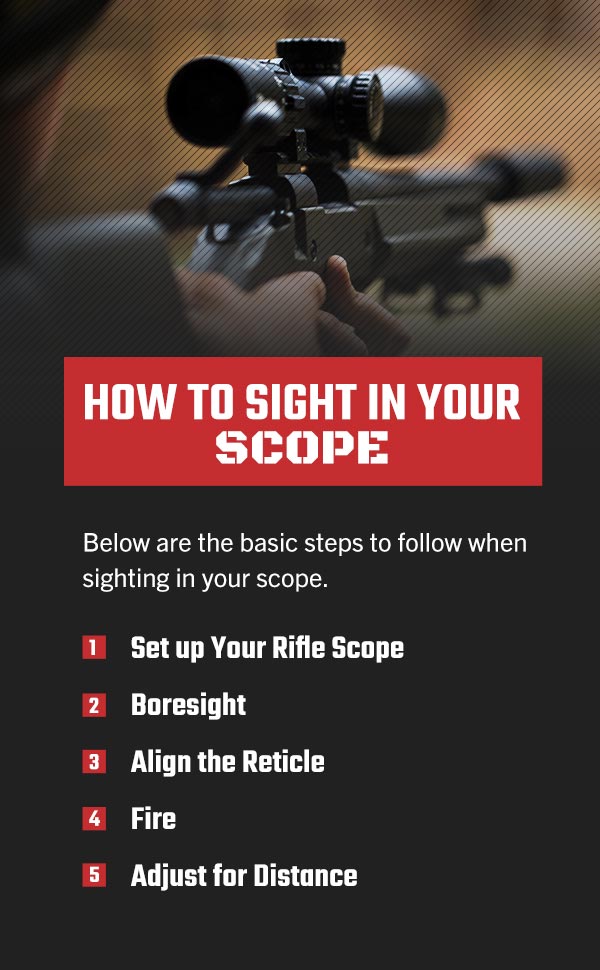
How to Sight in Your Scope
Now that we've covered the different types of scopes and turrets, below are the basic steps to follow when sighting in your scope.
1. Set up Your Rifle Scope
You'll want to mount your scope properly before you start sighting it in. Most modern rifles include a mounting system for a scope. Your rifle might have a grooved rail system or predrilled holes for scope bases. Ensure your scope mount and rings are the right fit for your rifle style — specific scope rings only fit particular types of scope bases, so these components must match.
Aside from ensuring the rings are secure and torqued to the recommended specifications, correctly setting the eye relief ensures enough distance between the scope and your eye so the recoil doesn't cause the gun to hit your eye when firing.
Adjust your eyepiece until you see a clear and distinct image. Creating the ideal amount of eye relief will likely require some fine-tuning, but it's a crucial step for your safety and sighting your rifle scope.
2. Boresight
It's vital to boresight a new scope before shooting your rifle. Start by clearing the rifle, unloading the gun and ensuring there are no obstructions in the barrel. Remove the magazine after clearing and unloading the rifle. From there, you can mount your rifle on a secure resting point, aiming the barrel downrange.
To boresight your rifle, place it on a shooting rest. Stand behind the rifle and look through the rifle barrel, or bore. Try to center the target in the bore, making slight adjustments as needed by carefully moving the rifle.
Centering the scope without moving the rifle is the goal. Try to center the reticle on the same target you're viewing down the bore.
3. Align the Reticle
Next, you'll need to focus the crosshair, or reticle, on the scope. Point your scope at a solid background, like the sky. Look away at a distant tree or cloud, then return your eyes to the scope. Confirm that it's immediately sharp and in focus — you don't want to wait for your eyes to adjust.
Adjust the diopter if your reticle appears slightly blurry. Continue adjusting until the reticle is instantly clear when looking through the sight. Additionally, make sure the reticle is parallel and aligned to windage and elevation. In other words, it should look like a perfect cross when looking through the scope. Aligning the reticle in closer shots is essential for shooting from longer distances later on.
4. Fire
If it's your first time mounting a scope on your rifle, you'll need to ensure your shots are in the crosshairs' general vicinity before moving the target further downrange in a step known as “getting on paper.”
This process makes it easier to pinpoint the initial relationship between the actual point of impact and the crosshairs. For instance, if you start with a target 100 yards away and the scope is way off, the shot likely won't even reach the paper and you won't know what scope adjustments to make. We recommend starting from 25 yards away.
You can start firing once you tighten your scope and focus your reticle. Aim at the target's center and fire a shot, using a shooting rest or sandbags to steady the rifle if needed.
After the rifle recoils, reposition it to the center with the action open. Hold it as steady as possible and look through the scope, adjusting the crosshair to the point of impact. Fire another shot and repeat this process if needed. Once you have centered your shot, you can try moving the target further downrange.
5. Adjust for Distance
When sighting in a rifle scope at different distances, remember that adjustments are small and move by a quarter-inch minute of angle, or MOA, for every hundred yards out. Generally, each quarter-inch will move your shot by an inch for each 100-yard increase.
Most rifle scopes allow you to adjust the crosshairs in quarter-inch MOA increments. You'll need to turn the elevation, or windage knob, four clicks to make your ammo impact move one MOA at 100 yards. The click value increases by a quarter-inch per 100-yard distance increase.
For reference, here's an incremental list of movement per click of your rifle scope's elevation for various distances:
- 200 yards: 1/2 inch
- 300 yards: 3/4 inch
- 400 yards: 1 inch
- 500 yards: 1 and 1/4 inch
- 600 yards: 1 and 1/2 inch
- 700 yards: 1 and 3/4 inch
- 800 yards: 2 inches
When you consistently fire grouped shots close to the target at each distance, you can fine-tune for targets that are farther away. Don't shoot too fast — give the barrel time to cool between shots.
While these are general tips and steps to follow, practicing at a range with an experienced shooter's help is ultimately the best way to sharpen your rifle scope sighting skills. Like anything else, consistency is key for sighting in your rifle scope. Try to get in as much range practice as possible and work on your shooting stance, grip, accuracy and drills to increase your shooting skills.
Tips for Different Zero Distances
In some cases, you might need to zero your rifle for a longer range than what's available to you. For instance, you may want a 200-yard zero but only have 50 or 100 yards available to make your adjustments. Here, some basic ballistic math comes in handy.
Remember that many common calibers, like .308 Winchester and .223 Remington, have about the same zero at 50 yards as they do at 200 yards. Therefore, if you adjust so that your point of impact and crosshairs align at 50 yards, you'll also be pretty close at 200 yards.
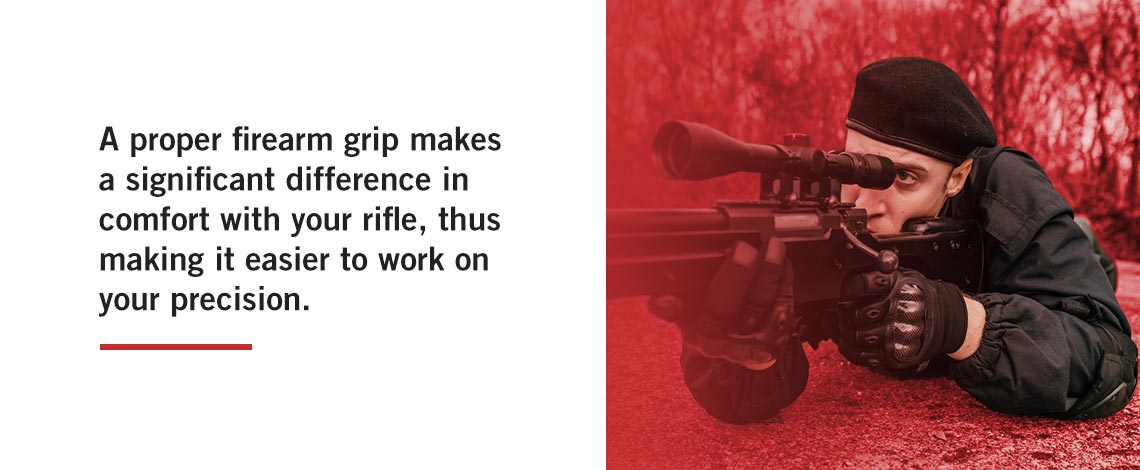
Gun Grip Tips
A proper firearm grip makes a significant difference in comfort with your rifle, thus making it easier to work on your precision. An effective grip reduces tension in your hands, helping you relax while lining up your shot. You'll want to ensure the gun fits comfortably in your hands so you don't think about it when it's in place.
Additionally, a good grip can reduce recoil and improve accuracy. However, the best rifle grip can be subjective. Some people prefer a more rigid grip, while others like it to be smoother. Find a grip that comfortably fits your hands and fingers. If you focus more on how the firearm feels in your hands instead of lining up your shot, it can interfere with your accuracy.
Scope Mounts From Wing Tactical
A reliable, high-quality scope mount is essential to practice sighting in your rifle scope. At Wing Tactical, we have various sight mounts in different designs, sizes and materials. Our selection features sight mounts from high-quality brands like the ones below.
Arisaka Defense
The Trijicon MRO Mount, Aimpoint Micro Mount and Aimpoint Acro Mount by Arisaka Defense include the following features:
- Low-profile, minimalist design
- All necessary tools and screws to attach the optic to the mount
- 1.70-inch and 1.93-inch heights
- 7075-T6 aluminum material
- Type III Hardcoat Anodized finish
Strike Industries
The Ambush 45-Degree Offset Optic Mount by Strike Industries has the following features and more:
- Low-profile and lightweight
- Strong, stainless steel mounting system
- Dual footprint, 6061-T6 aluminum mounting plate
- Ambidextrous for either side
Meanwhile, the Strike Industries Adjustable Scope Mount features:
- Combined eye relief options into a single scope mount
- Four settings — standard, extended, intermediate and hyperextended
- Ability to adjust the scope closer or away from you
- High strength yet minimal weight
- 7250 aluminum matieral
- Hardcoat Anodized finish
Battle Arms Development
The Battlearms Aimpoint Lightweight Optic Mount includes features such as:
- A single-piece, lightweight design
- 7075-T6 aluminum material
- Type III Hardcoat Anodized finish
- Easy rock-on and tighten mount
Improve Your Shooting Skills With Equipment From Wing Tactical
After reading the above shooting tips and steps for sighting in your rifle scope, you might feel inspired to try it or enhance your current sighting skills. If you're looking for gear and equipment to improve things like accuracy and distance, turn to Wing Tactical for your firearm equipment needs. You can also enjoy the following benefits when you shop with us:
- Military and law enforcement discounts
- Quick shipping
- Handpicked products
- Outstanding customer service and satisfaction
- Hassle-free, 30-day returns
Boost your shooting abilities with high-quality gear from Wing Tactical. Browse our scope mounts and other gun accessories, or contact us with any questions about our products!
